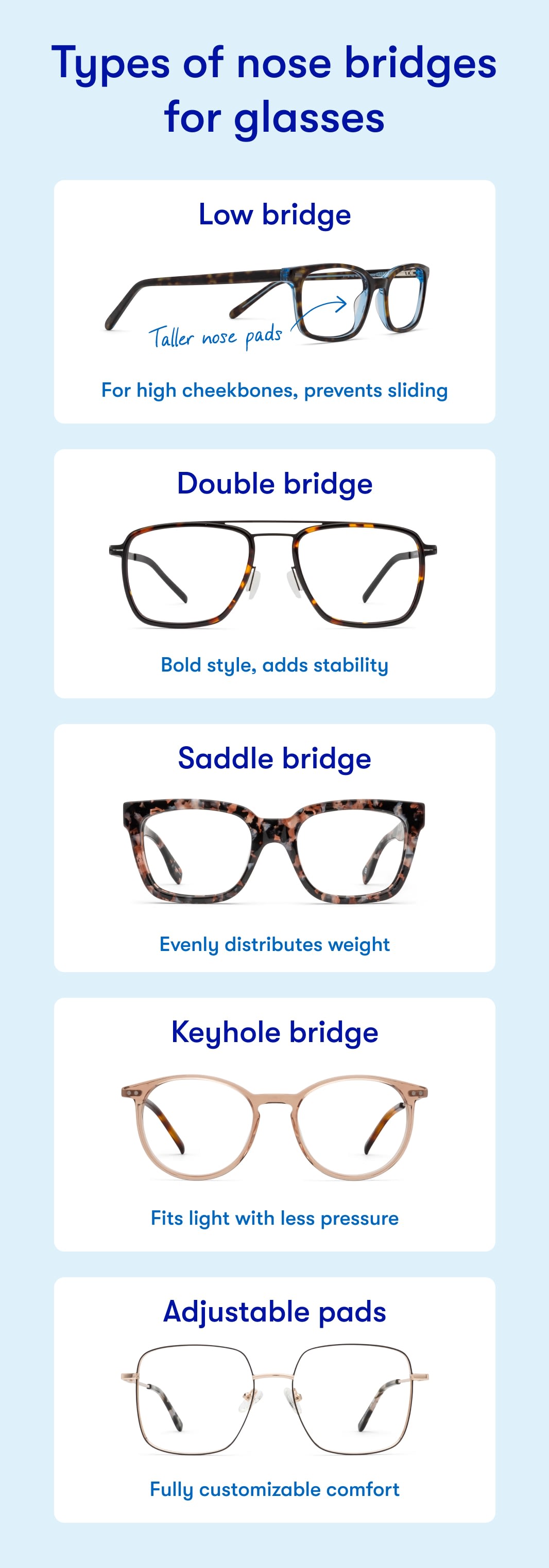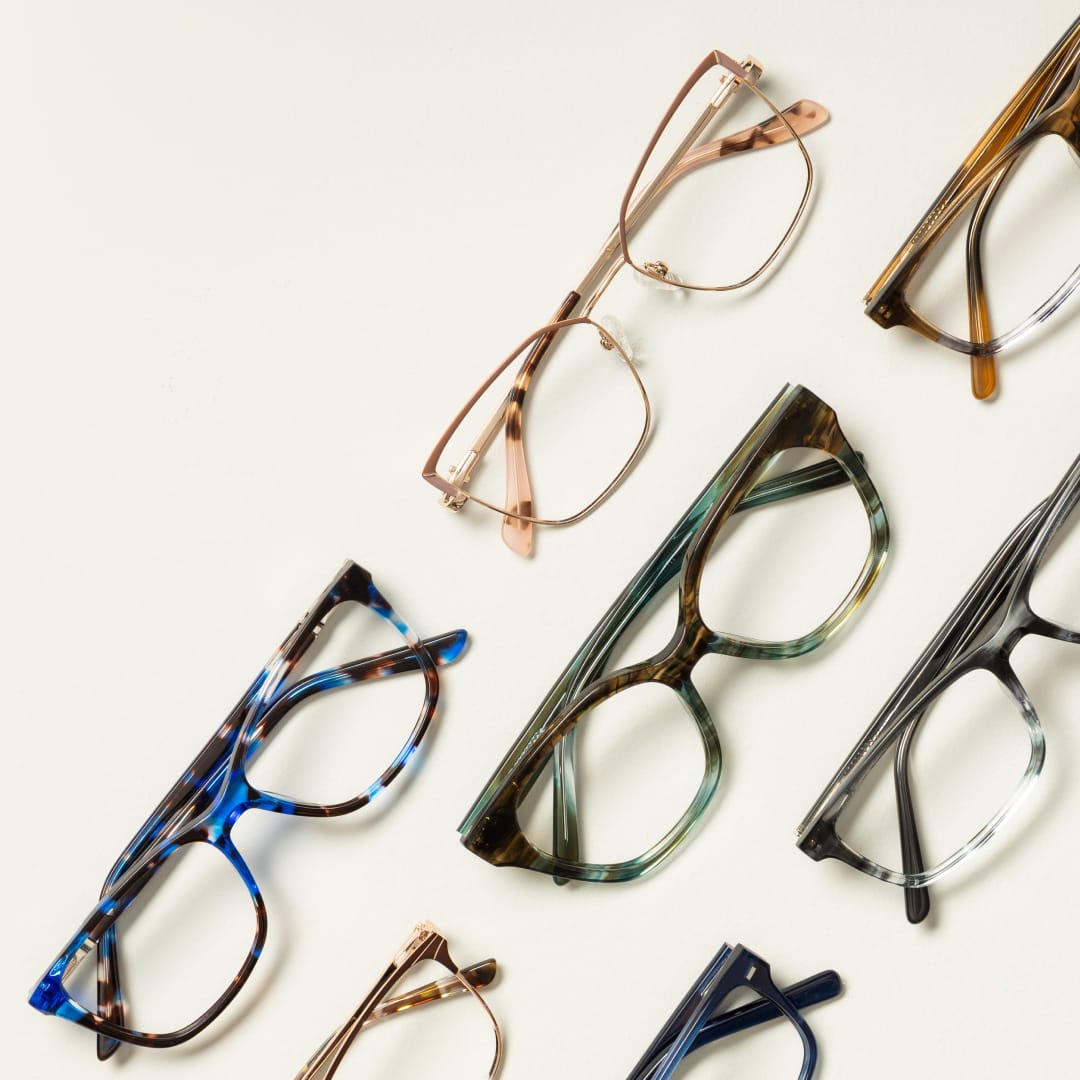Types of nose bridges for glasses
Have you ever ordered a pair of glasses that looked amazing when you used online try-on technology, only to have them slide down your nose in real life? Or have you felt the pinch and poke of glasses that were just too snug and left tiny indents on the bridge of your nose? These signs can indicate you purchased frames with a bridge type that doesn't work for you.
Turns out, not all nose bridges — and certainly not all noses — have the same shape. When it comes to comfort, style, and the ability to go a whole day without readjusting your frames, the type of nose bridge on your glasses matters.
Here's a quick look at five common types of nose bridges for glasses, including which shapes they tend to be suited for:
-
Low bridge: Best for those with lower nose bridges and higher cheekbones
-
Double bridge: Great for those with a strong nose shape or high bridge
-
Saddle bridge: Great if you like a snug fit, as it spreads the weight evenly across your nose
-
Keyhole bridge: Best if you want a lighter feel, as it leaves a little space on top of the nose
-
Adjustable nose pads: Ideal when flexibility is critical, as you can customize the fit
Do nose bridge terms sound like a different language to you? Don't worry; we dive deeper into each nose bridge type below.

Low bridge
Low-bridge glasses are narrowed or curved, helping them rest securely on noses that sit lower on the face. Unlike traditional frames, which might slide down or rest on the cheeks, low-bridge designs can offer a more stable, comfortable fit.
People with lower nose bridges, flatter nose profiles, or higher cheekbones might find low bridges helpful. Low bridges might also be a good option if you don't like to feel your clothing or accessories — lifting the frames off your cheeks keeps yet another sensory overload from impacting your day.
Benefits of low bridge glasses include:
-
Reduced sliding down the nose
-
Reduced contact with the cheeks
-
More natural, centered lens placement
-
Improved comfort for those with flatter nose bridges
Double bridge
Double-bridge glasses are exactly what they sound like: a bridge with a double bar connecting the lenses. One bar is a traditional bridge. The other is a second bar above it that provides added stability and design flair. These types of glasses tend to look bolder.
Double-bridge styles are a good option for those with prominent or high nose bridges. They're also a good choice if you want your frames to be a bold fashion accessory with a retro or rugged look.
Benefits of double-bridge glasses include:
-
Added support and stability
-
Vintage-inspired designs that can be fashionably fun
-
Help balancing facial proportions and drawing attention to the eyes
Saddle bridge
Saddle-bridge glasses are named for their shape. They curve smoothly over the nose like a saddle on a horse. This design helps distribute the weight of your frames evenly across the top and sides of your nose.
Saddle-bridges might work well for people who prefer a snug fit without pressure points. If your glasses tend to leave marks or pinch your nose, a saddle bridge could provide a break for the skin around the bridge of your nose. Saddle bridges are also helpful if you have heavier frames, as they help reduce the weight on your nose (so it can be more horse than mule).
Benefits of saddle bridge glasses include:
-
Even weight distribution for added comfort
-
Reduced single pressure points
-
Secure fit that supports long-term active wear
-
Sleek, classic design that works with many frame styles
Keyhole bridge
The keyhole bridge is named for its distinctive shape, which includes a small gap between the bridge and the top of the nose. Instead of resting directly on the nose, this bridge type is anchored on the sides. The result is that the weight of the frames is spread outward, creating a lighter feel.
Keyhole bridges are often a good choice for people with smaller noses or narrower bridges. If you find a standard bridge too heavy or pinching, try a keyhole option. Keyhole bridges also work well if you want more airflow around your nose or like the added design flair.
Benefits of keyhole bridge glasses include:
-
Lighter fit with less pressure on the top of the nose
-
Classic vintage-inspired design
-
Increased comfort for smaller or narrow nose shapes
-
Reduced risk of red marks or indentations on your nose
Adjustable nose pads
Adjustable nose pads are small, movable pads that attach to the inside of the bridge on glasses. Typically, the pads sit on a small part of the frame that can be moved slightly, so you can fine-tune the fit. This type of bridge lets you customize frames to sit higher or lower on your nose, and you can also adjust how firm the bridge "grips" your nose.
This bridge type may be best if you want more control over how your glasses sit on your face. Individuals with progressive or bifocal lenses may find adjustable nose pads helpful, as they help you dial in where your viewing sections are. Adjustable nose pads also work well for different sensory thresholds, depending on your mood. You can also create a snugger fit when playing sports. (You want the ball to fly across the net, not your glasses.)
Benefits of adjustable nose pad glasses include:
-
A fully customizable fit
-
Better weight distribution to reduce pressure points
-
Increased stability for active wearers

The Framery at 1-800 Contacts
Get premium frames starting at $79
Shop glasses
How to tell what kind of nose bridge you have
Not sure if your nose bridge type is low, high or something in between? Knowing your nose bridge type helps you buy the right frames in the future and find options that don't slide or pinch all day.
Here's how you can check what type of nose bridge you have:
-
Stand in front of a mirror in good lighting.
-
Look straight ahead.
-
Locate your pupils and imagine a horizontal line running through them.
-
Check where your nose bridge starts. If it starts at that line or below it, you may have a low bridge. If it starts above that line, you likely have a high bridge.
You can also look at your cheekbones and how your existing frames sit. If frames often seem to rest on your cheeks, you may have a low bridge. Frames constantly sliding down your nose could also indicate a potential low bridge.
Low nose bridge vs. high
A low nose bridge starts at or just below the line of your pupils. People with this nose shape often have higher cheekbones, which means standard frames can slide down or rest on their cheeks.
A high nose bridge starts above the pupils. Glasses tend to sit more securely on the nose without extra adjustments, and you have more frame options without worrying about fit.
Need some visual references? Think of celebrities like Emma Stone or Bruno Mars (low bridge) versus Tom Hiddleston or Gal Gadot (high bridge).
Best frame types for:
-
Low bridge: Adjustable nose pads, low-bridge frames, or keyhole bridges
-
High bridge: Saddle or double bridges, as well as most standard fits
The importance of understanding which nose bridge you have
Finding glasses that look great is only half the battle — comfort and fit matter just as much. Knowing your nose bridge type helps you skip the trial-and-error and land on frames that work for your face. Increase your chances of a good fit the first time by understanding your nose bridge and your pupillary distance.
Here’s why it matters:
-
Better comfort: Stop glasses from slipping, pinching, or leaving red marks.
-
Improved vision: Lenses sit where they’re supposed to, so your eyes look out the part of the lenses they need to.
-
Fewer returns: Save time and money by getting it right the first time.
-
More confidence: A great fit makes your frames feel like they were made for you.
Find your ideal glasses nose bridge with free in-home try-on options.





